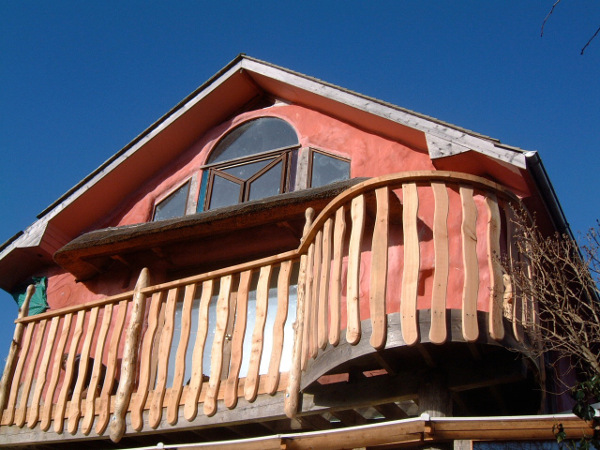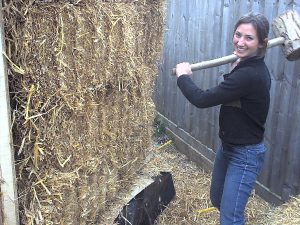Almost twenty years ago I left the life I knew to live on an acre of terraced woodland in Pembrokeshire. A friend helped me to build an 8x12ft shed and I had the beginnings of my own home. In all naivety, I thought I could live on my own land until a planning officer appeared. With a tumbled down ruin on the land, I voiced that I would apply for planning permission and so was allowed to stay on the land whilst applying.
Meanwhile, I built a compost loo and shelter and installed a tiny woodburning stove. These and a small gas stove and rainwater butt were my few resources. I lived in the shed for almost eight years without water or electricity until a small straw bale extension was added with a 125w solar panel and battery.
I treasured that time. I treasured carrying water up the long track to the hut and collecting sticks to burn; to heat the water; to cook my food; to wash the dishes and to wash my body in a washing up bowl or out under the tree tops and then to dry wildly in the wind or sun. I treasured not having to earn much money and so spent much time in contemplation in Nature which opened doors within my own Nature and without. This then led me also to the herbs, the wild things and flowers and to make oils, essences and remedies. I treasured the time to watch the seasons turn from green to gold, to copper, to dust…
Eventually a senior planning officer appeared to talk over my application. Agenda 21 had just been adopted by Pembrokeshire County Council and my vision was to build a self sustainable home powered by the sun and the wind. The officer like the proposal and said it wouldn’t be very easy but that she would do what she could to help. There was some local opposition; mainly the kind coming from fear and the threat of the new but there was also a good deal of support from friends and family. Somehow the seeming obstacles fell away as I confronted each one that came my way, including a two tonne boulder placed on my path one day…. which was removed quite rapidly by a local farmer and after two years I was eventually granted planning permission.
 During this time I had built a small straw bale extension onto my hut with some helpful friends and loved the quiet ways of building with bales. My building control officer after a meeting with myself and Barbara Jones of Amazonails was satisfied with the plan to build the house with straw bales so in 2003 I began a self build project with guidance from Barbara who helped with drawings and running courses to raise the house. The only compromise was some concrete in the foundations as planning permission was running out and needs must get the foundations in leaving no time to research and convince planners about rammed earth tyre foundations; a preferred option.
During this time I had built a small straw bale extension onto my hut with some helpful friends and loved the quiet ways of building with bales. My building control officer after a meeting with myself and Barbara Jones of Amazonails was satisfied with the plan to build the house with straw bales so in 2003 I began a self build project with guidance from Barbara who helped with drawings and running courses to raise the house. The only compromise was some concrete in the foundations as planning permission was running out and needs must get the foundations in leaving no time to research and convince planners about rammed earth tyre foundations; a preferred option.
From there I worked with stone from the ruin as a plinth wall for the straw balls to sit upon a wall plate. Women friends from the village came up to help and to learn how to build stone walls with lime mortar. There was a timelessness about it and a deeply buried memory of how this was done before; friends, families, communities building homes together.
Four hundred bales arrived along with Barbara Jones for our first straw bale build course. It was very exciting, as building and working with straw always seems to be. I discovered that this was to be the first two storey load bearing straw bale house in the UK and the second in Europe. Load bearing saves on timber, having no wooden framework and hence less carpentry involved, however it does require attention to keeping bales dry during the build until the roof is fixed down to a roof plate with tie downs to foundation level.
More courses happened for internal clay and external lime plastering and over the 2/3 yr process we had over two hundred volunteers coming to learn, share and help and then leaving to take their skills into their own lives and builds. The roof was covered with cedar shingles. Most windows were salvaged and most timber locally sourced larch and oak.
 One woodburner heats the whole house with back up under floor heating system running from a back boiler, also heating the water. Five hundred watts of solar panels and 1kw wind turbine powers the house and rainwater is harvested for bathroom use. The two storey house cost around £60,000 to build, at a size of 160sqm. This includes all renewable energy and a few learning curves… and now no bills except a gas bottle every few months for cooker backup. Biomass is coppiced on site.
One woodburner heats the whole house with back up under floor heating system running from a back boiler, also heating the water. Five hundred watts of solar panels and 1kw wind turbine powers the house and rainwater is harvested for bathroom use. The two storey house cost around £60,000 to build, at a size of 160sqm. This includes all renewable energy and a few learning curves… and now no bills except a gas bottle every few months for cooker backup. Biomass is coppiced on site.
In 2008 the house was nominated and voted by the public as Grand Designs Eco Home of the year. Since then we have run the Quiet Earth Project and Retreat, supporting and running courses for other straw bale and low impact projects. From this woodland home now we also offer conferences and courses in Off Grid and Sustainable Living, Open Days, Contemplative retreats in Nature, Yoga, ceremony and currently a forest garden is being cultivated. There are wwoofing / volunteering opportunities and time also available to spend retreat time in the woodland. I’m presently working on a book about the life here in nature and the process and creation of a natural dream home.



4 Comments
Wonderful. It gives hope to the rest of us who want to live close to nature, but are prevented from doing so by ridiculous rules and regulations!
Sounds like a wonderful experience and a beautiful result
I want to install a woodburner into our straw bale garden hut. Any advice on this would be greatly appreciated, thanks
Hi Janie, It would depend on size. I have a straw bale garden hut also and a small squirrel morso stove is perfect for keeping it cosy in the winter. The plaster on the walls serve as thermal mass.